After the indulgences of Japanese New Year celebrations, we enjoy Nanakusa Gayu (七草粥) or seven herb rice porridge on January 7th. This mild and comforting okayu allows our stomachs to recover from the feasts we enjoyed during the holiday in Japan.
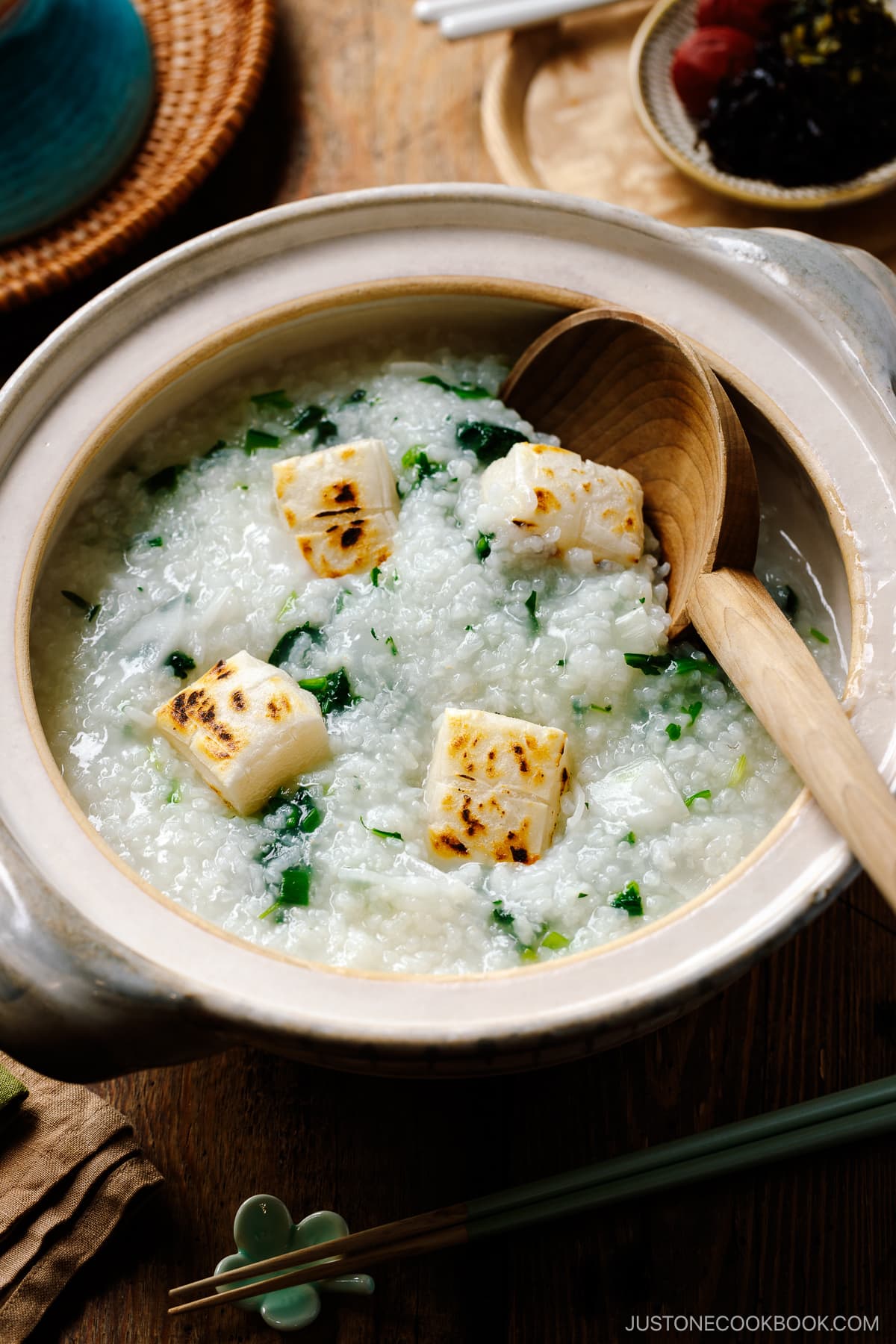
On January 7th each year, the Japanese observe a tradition known as Nanakusa no Sekku (七草の節句), or the Festival of the Seven Herbs, by eating a healthy rice porridge called nanakusa gayu (七草粥). This time-honored custom is believed to bring good health and ward off evil spirits for the rest of the year.
The simple meal of rice porridge hits the spot after all the New Year feasting and helps our overindulged stomachs to heal and recover. If you’re ready for a reset, this tasty yet light porridge is a delicious way to get back on track.
Table of Contents
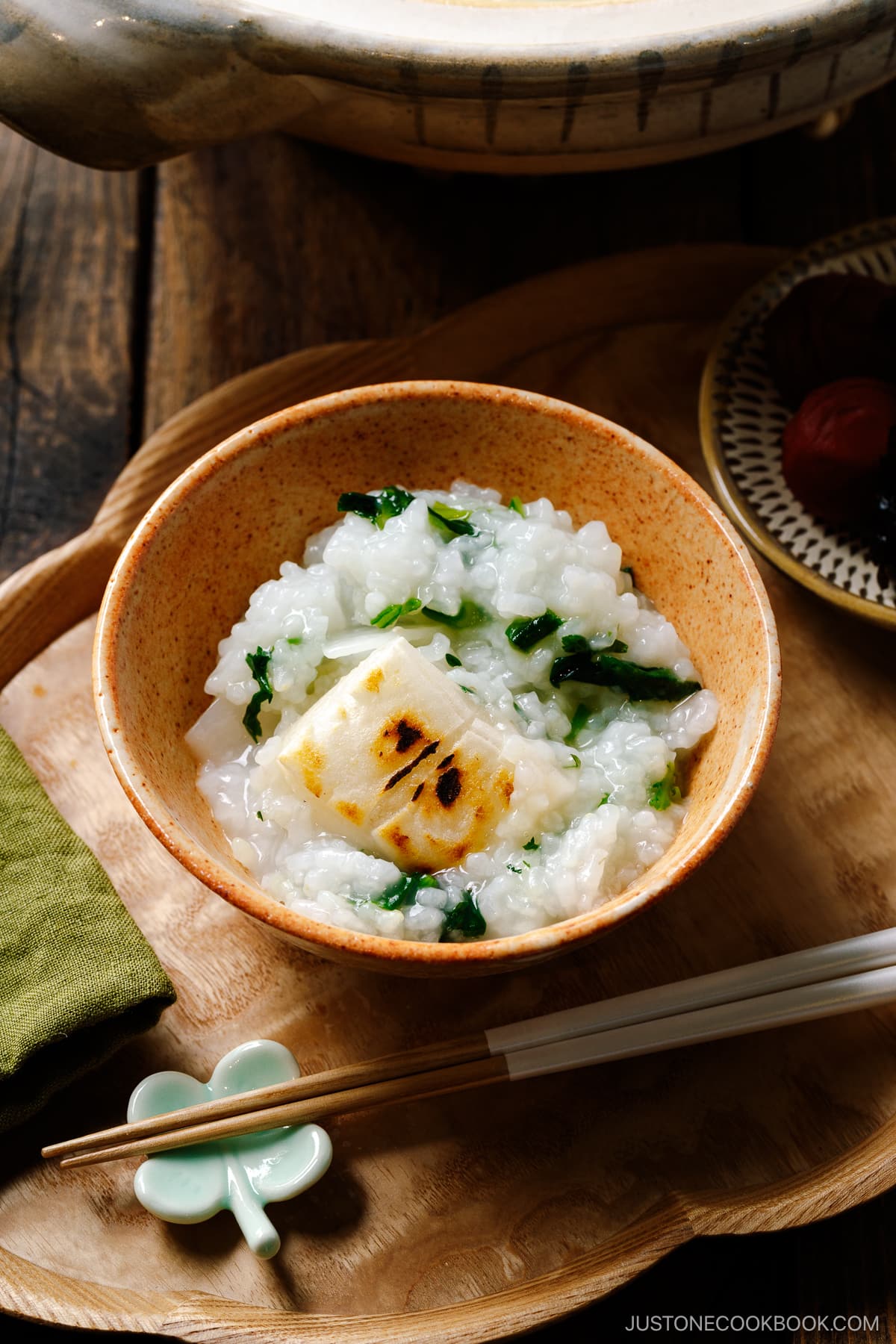
What is Nanakusa Gayu?
Nanakusa gayu (seven herb rice porridge) is a type of okayu, or rice porridge, made with seven herbs (七 nana 草 kusa). We sometimes call it haru no nanakusa (春の七草), which means “spring‘s seven herbs,” because the young herbs that are available during this time of year are more tender and fragrant.
The custom of eating hot rice porridge on the 7th day of the Japanese New Year has its roots in Chinese belief and traces back to ancient times in Japan. Based on the Chinese legend, January 7th is also known as Jinjitsu (人日), one of the 5 seasonal festivals (節句), during which we celebrate everyone’s birthday as it is considered the day humans were born.
In Japan, we usually eat a plain bowl of okayu when we’re feeling under the weather because it is light, comforting, and easy on the stomach. It heals any heavy feelings or sicknesses. As we wrap up the New Year festivities, it makes sense to eat nanakusa gayu. Since there is little green during the winter, the porridge’s young herbs bring color to the table and represent renewal for the new year.
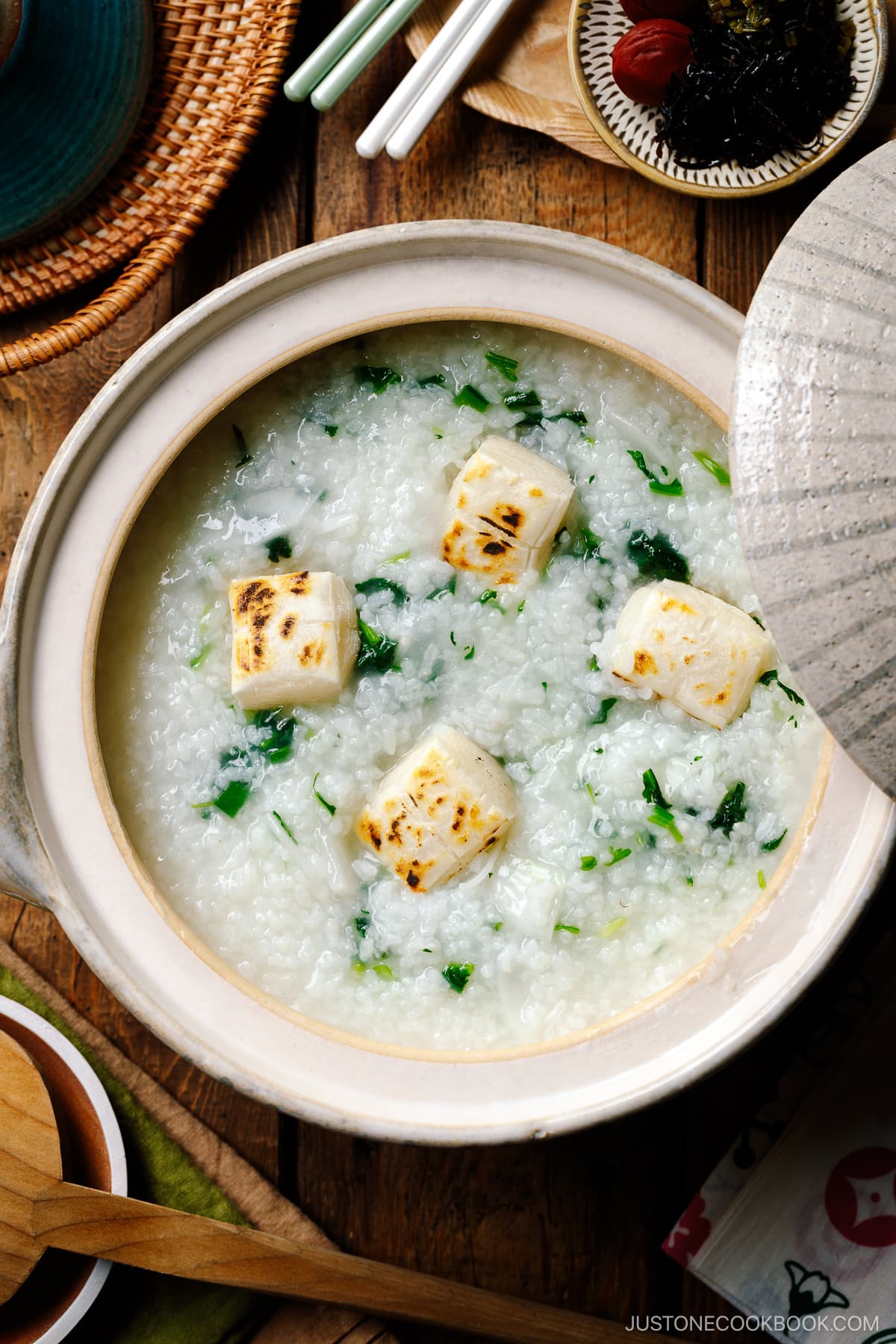
What Are the Nanakusa (Seven Herbs)?
Here are the seven herbs used in nanakusa gayu:
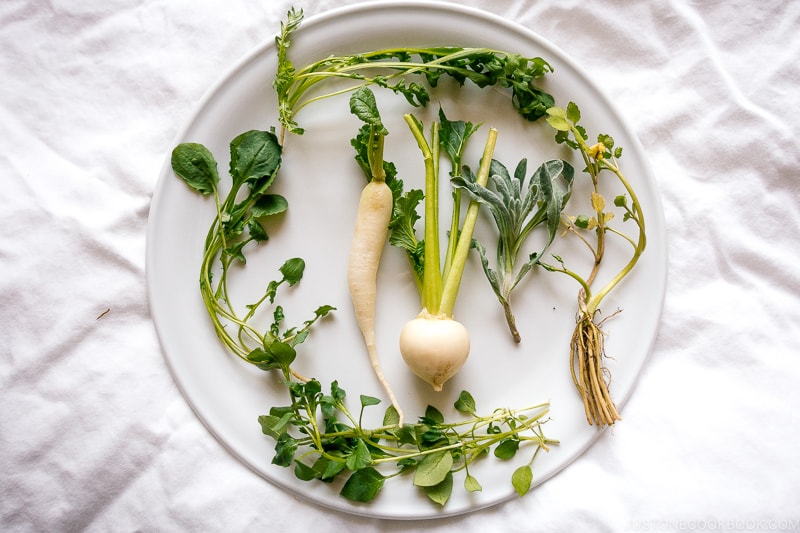
- Water dropwort – Seri (せり)
- Shepherd’s purse – Nazuna (なずな・ぺんぺん草)
- Cudweed – Gogyo (ごぎょう)
- Chickweed – Hakobera (はこべら)
- Nipplewort – Hotokenoza (ほとけのざ)
- Turnip – Suzuna (すずな・かぶ)
- Daikon radish – Suzushiro (すずしろ・大根)
🎶 To help remember the herbs, we even have a song that goes like this: “Seri Nazuna, Gogyo Hakobera Hotokenoza, Suzuna Suzushiro Korezo Nanakusa.”「せり なずな、 ごぎょう はこべら ほとけのざ、 すずな すずしろ、これぞななくさ」
Where To Find Nanakusa
In Japan
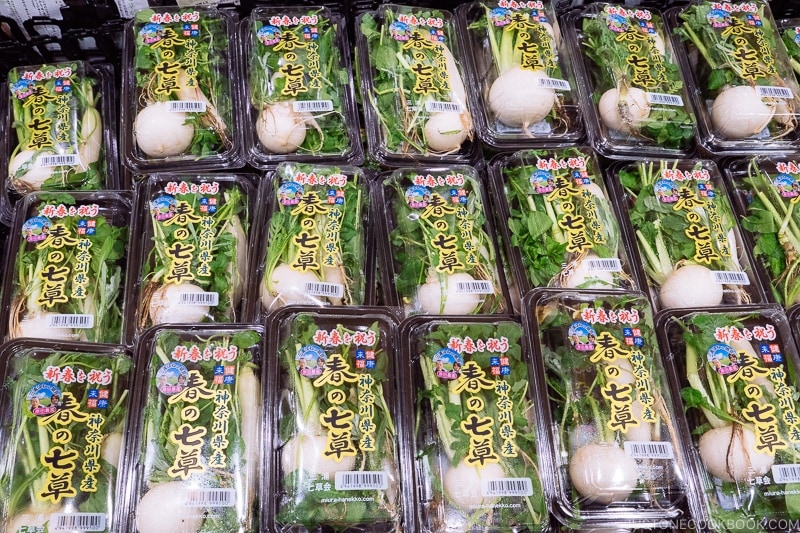
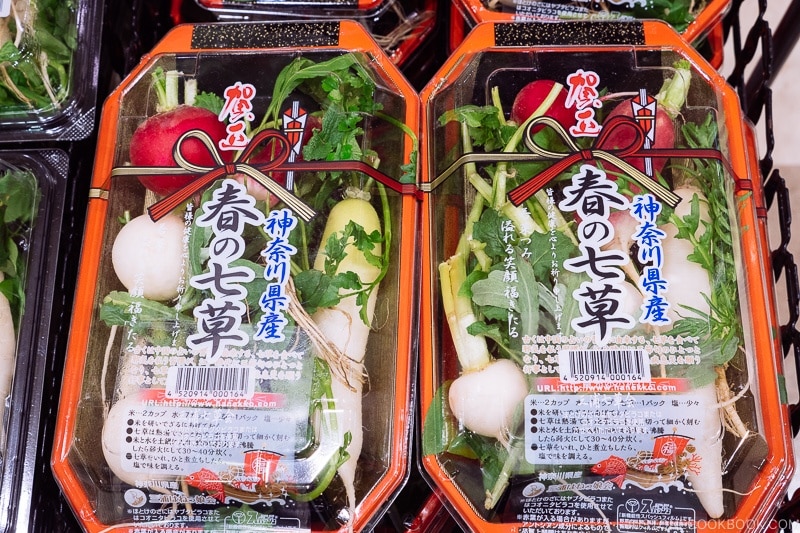
You can find convenient “Haru no Nanakusa Set” (春の七草セット) packages in grocery stores in Japan. They are a bundle of fresh herbs ready to use in making nanakusa gayu.
Outside of Japan
It’s challenging to find all seven traditional herbs outside of Japan. However, you can still make nanakusa gayu and enjoy the porridge at home.
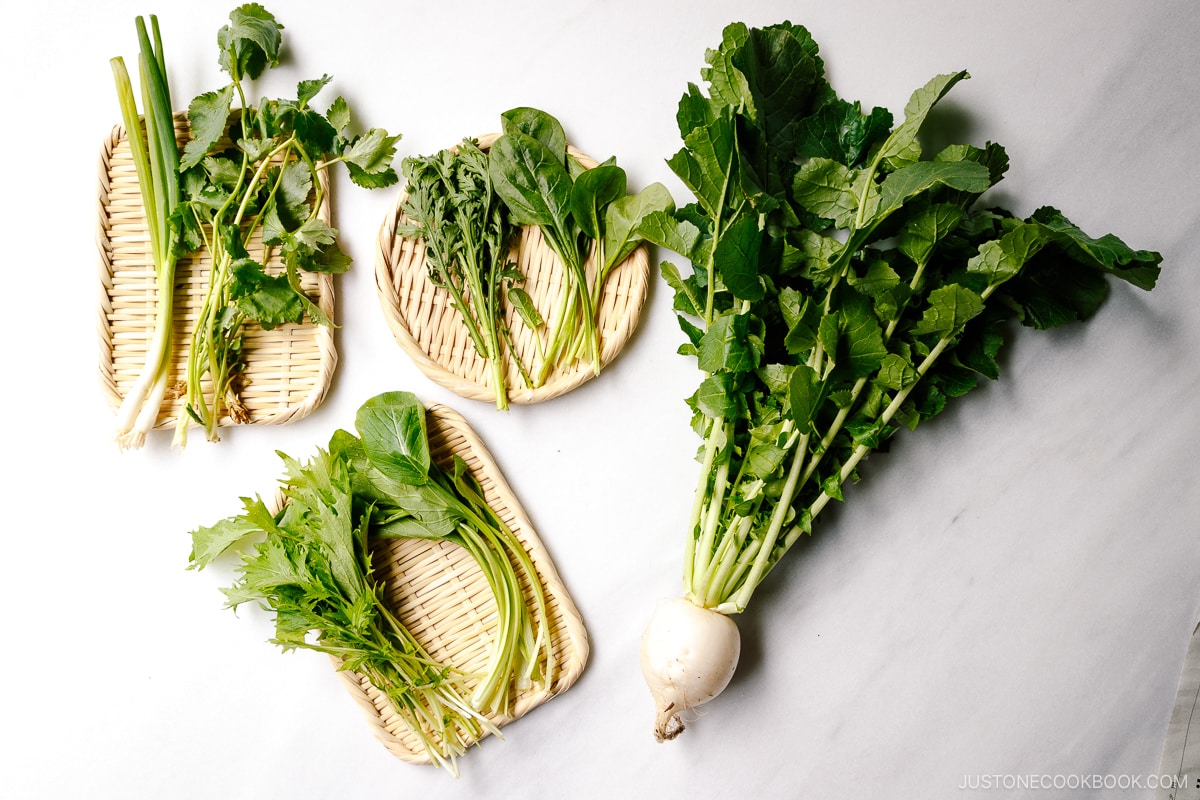
Locally available herbs/greens: Over the years, I’ve cooked with various herbs and made my own versions, and each one turns out just as delicious. Here are some greens I’ve used from a Japanese market:
- Daikon leaves and daikon radish – Got this fresh one from my neighbor’s garden!
- Spinach
- Chrysanthemum greens (shungiku)
- Komatsuna greens
- Mizuna
- Mitsuba
- Green onions/scallions
You can also use basil, chervil, chives, fennel, mint, and watercress. Use a selection of greens you enjoy that are available near you. Make sure nothing is too strong or dominant in the amount that overpowers the flavors.
Freeze-dried nanakusa: You can also buy a freeze-dried nanakusa package from Japan at a Japanese grocery store in your area.
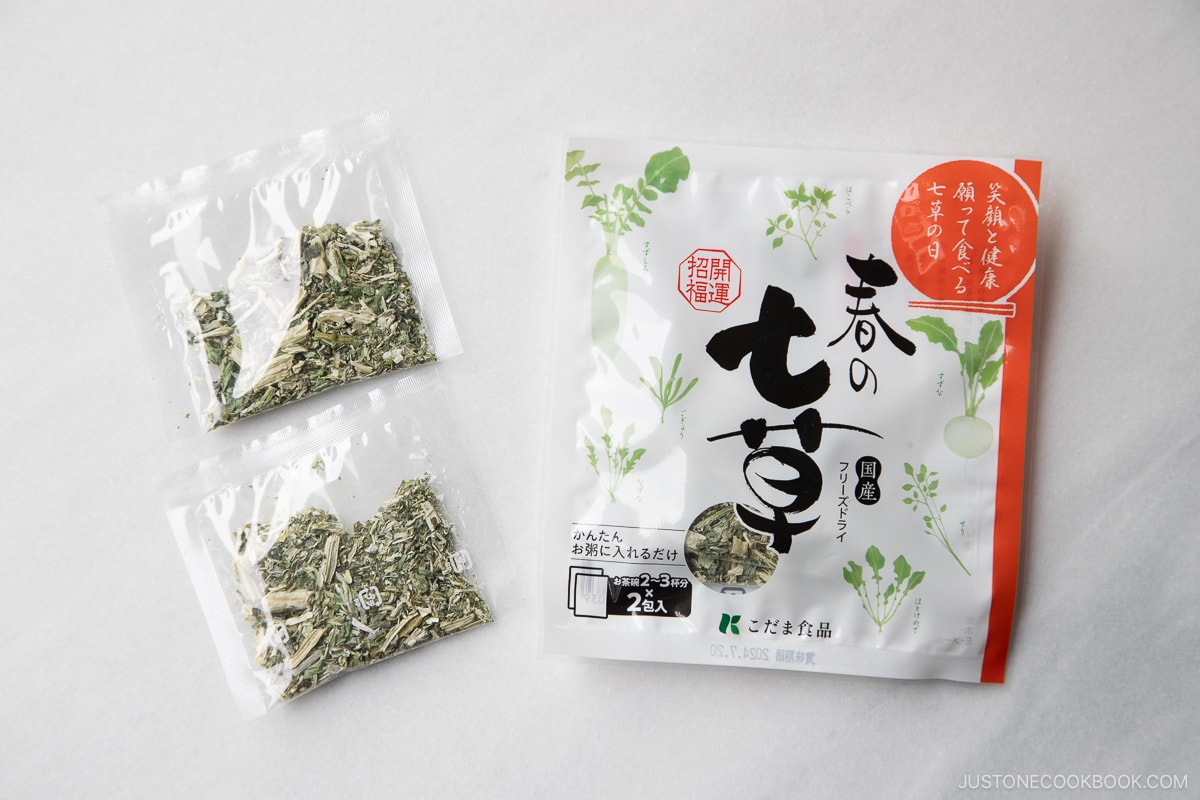
How to Make Nanakusa Gayu
It’s very simple and easy to make Japanese rice porridge. Here’s a quick summary of how to make it. For precise ingredients and step-by-step instructions, see the recipe card below.
Jump to Recipe- Wash the rice and drain well. Put the rice and measured water in a heavy-bottomed pot.
- Bring it to a boil over medium heat. Stir the rice once it boils, then reduce the heat to low. Cover with the lid slightly ajar and cook for 30 minutes.
- While the rice is cooking, prepare the daikon and the herbs/greens. Cut the daikon into thin slices and cut the herbs/greens into halves or thirds. Cook the daikon until tender and blanch the herbs/greens for 20 seconds.
- Once the porridge is done, season to taste with salt.
- Add the cooked daikon and herbs/greens.
- Cover and let it steam for 5 minutes.
- Optionally, you can add toasted mochi pieces on top. Enjoy!
Rice-to-Water Ratio for Rice Porridge
I use 1 rice cooker cup (180 ml) of uncooked Japanese short-grain rice and 1 L (1000 ml) of water to make nanakusa gayu. I like this ratio because it’s easy to remember. It also has the typical zengayu (全粥) consistency, with barely any liquid left in the pot after cooking.
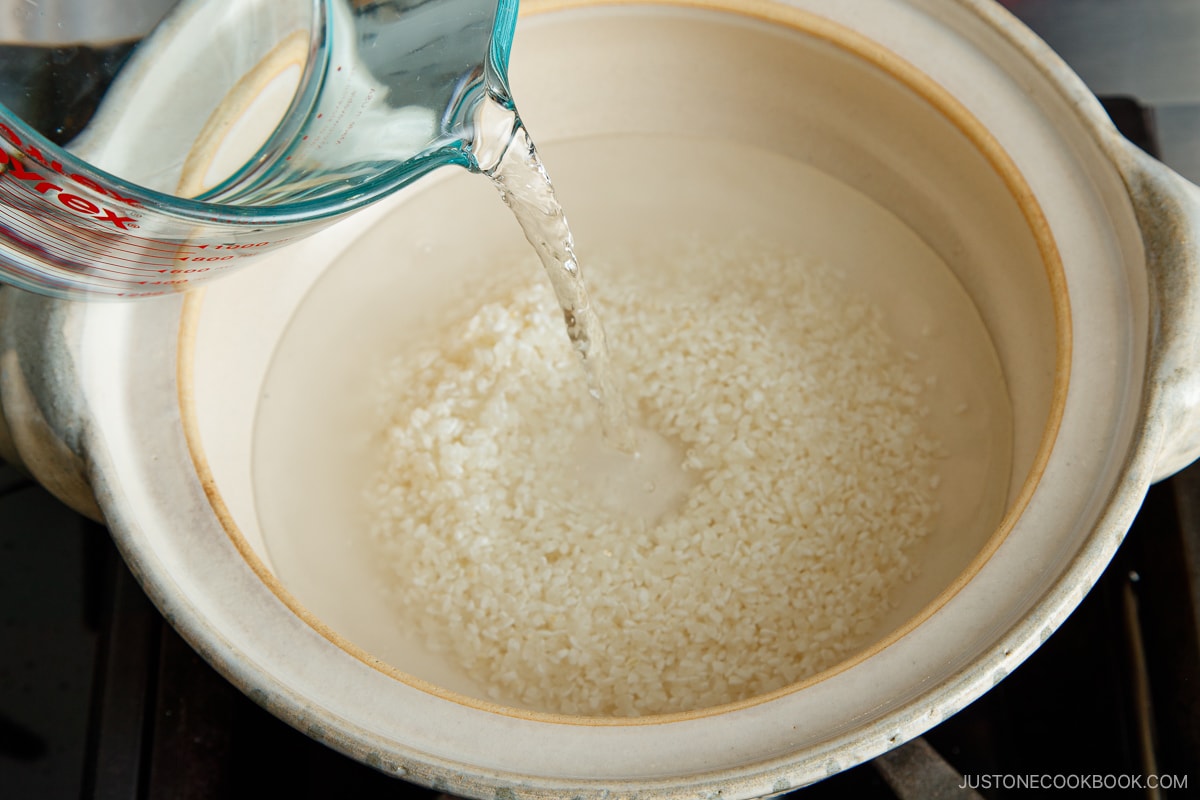
If you like a more watery consistency, you can increase the water amount to 1.2 L (1200 ml).
Rice-to-Water Ratios for your Desired Consistency (1 rice cooker cup is 180 ml):
- 1:5 – Zengayu (全粥, 五倍粥) = 1 rice cooker cup + 900 ml (not much water left)
- 1:7 – Shichibugayu (七分粥, 七倍粥) = 1 rice cooker cup + 1260 ml
- 1:10 – Gobugayu (五分粥, 十倍粥) = 1 rice cooker cup + 1800 ml
- 1:20 – Sanbugayu (三分粥, 二十粥) = 1 rice cooker cup + 3600 ml (very watery)
Make Porridge Using Cooked Rice
You can make Nanakusa Gayu with cooked rice. Use leftover rice or defrost frozen rice. (Freezing is the best way to store cooked rice!) The ratio of cooked rice to water (by volume) is 1:2 or 1:3.
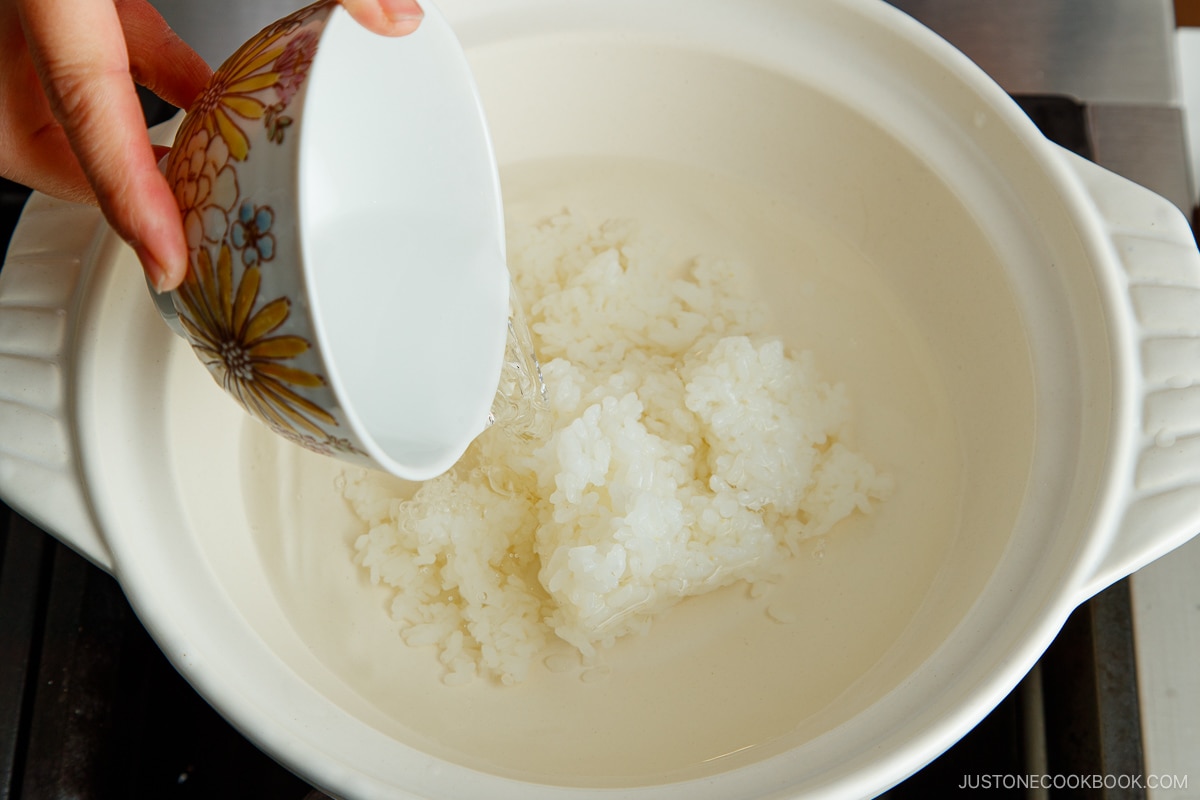
The easiest way to measure is with a Japanese rice bowl. For 2 servings of rice porridge, use 1 rice bowl (200 ml size) of cooked rice and 2–3 rice bowls of water. For zengayu consistency, use 2 rice bowls of water.
Cooking Tips
If you’re new to making rice porridge, here are a few things to keep in mind:
- Use a heavy-bottomed pot like a donabe (Japanese clay pot) or Dutch oven. The rice cooks more evenly because thicker pots distribute heat beautifully compared to regular, thinner pots that tend to have hot spots.
- When cooking the rice, cover the pot with the lid slightly ajar, especially if the pot is shallow or does not have much space. This prevents pressure and steam from the starchy water from building up and boiling over. Do not open the lid or stir while cooking.
- Turn the heat to medium to bring it to a boil, then reduce to low and cook for 30 minutes. Turn off the heat and let it steam for 5 minutes.
- Blanch the herbs/greens in salted water separately, then add them to the porridge at the end to help maintain their bright color.
- Optionally, add toasted rice cakes on top. While my mom did not add kirimochi to her Nanakusa Gayu, I learned that some people do, and my family loves it! It’s a great way to use up leftover kirimochi from Japanese New Year.
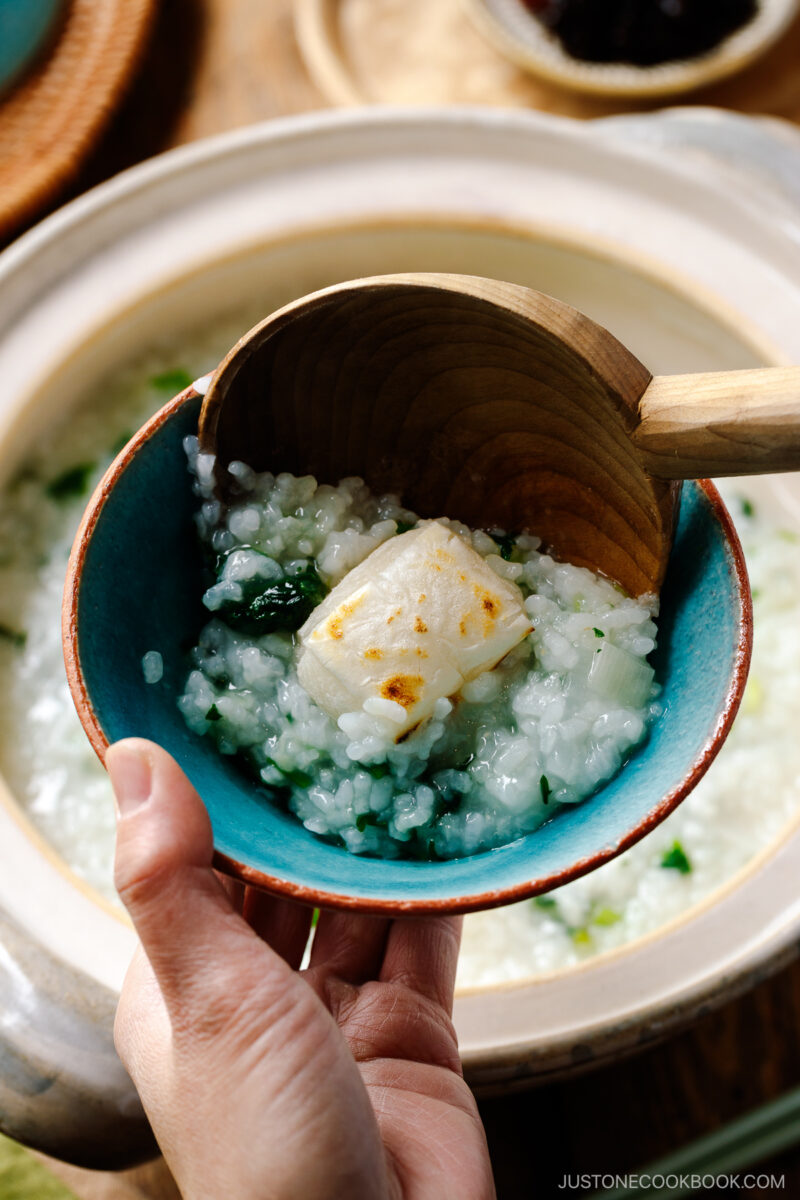
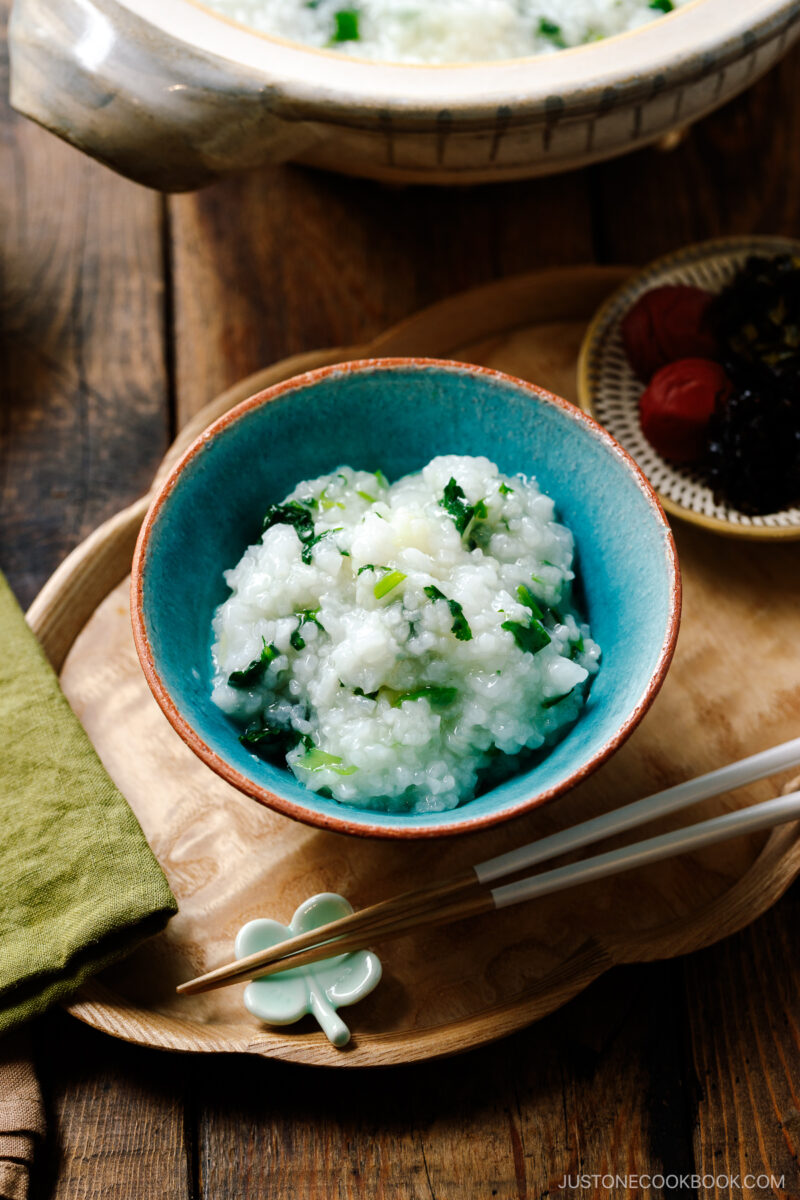
Use Donabe (Japanese Clay Pot) for Nanakusa Gayu
For the best-tasting okayu, I recommend using a donabe (土鍋), a Japanese earthenware pot, to cook the porridge.
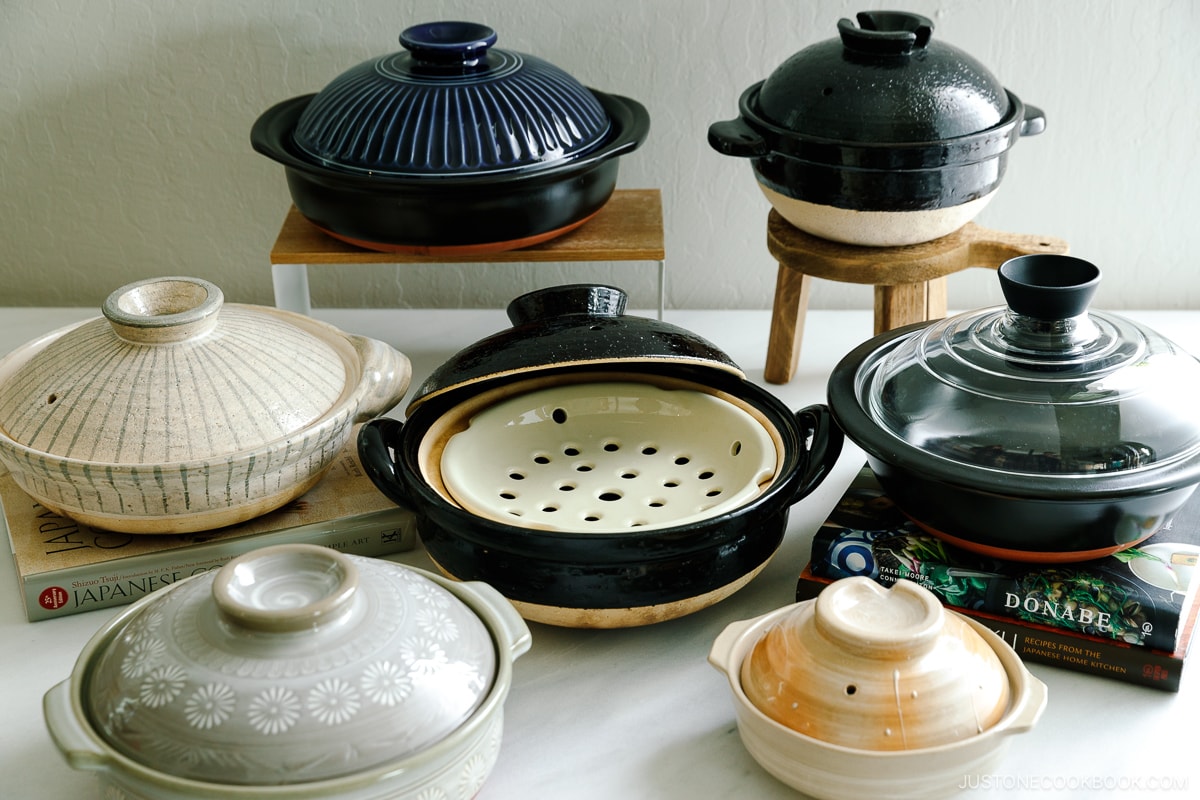
This traditional clay pot distributes heat beautifully and retains heat well, and it makes lovely serveware for nanakusa gayu. It certainly suits the spirit of Japanese New Year to serve such a meaningful meal in a traditional donabe.
If you are shopping for a donabe, please see my tips on how to choose the best donabe for you. Before you use your donabe for the first time, please learn how to season and care for your donabe.
More on Japanese New Year Traditions and Foods
- How Do The Japanese Celebrate The Japanese New Year
- Toshikoshi Soba (Japanese New Year’s Eve Noodles)
- Osechi Ryori (Japanese New Year Food)
- Kagami Biraki – Mochi Breaking Ceremony
- Eating Nanakusa Gayu on The Festival of the Seven Herbs

Wish to learn more about Japanese cooking? Sign up for our free newsletter to receive cooking tips & recipe updates! And stay in touch with me on Facebook, Pinterest, YouTube, and Instagram.
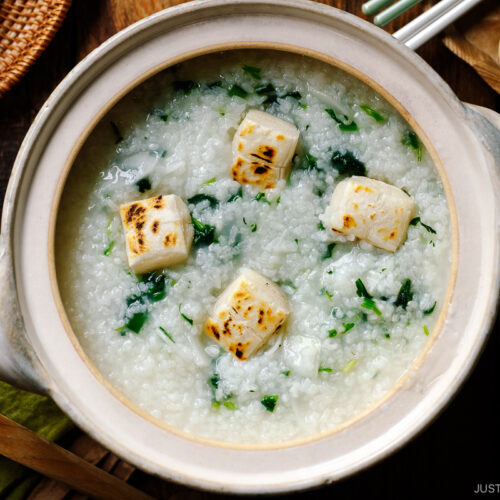
Nanakusa Gayu (Seven Herb Rice Porridge)
Ingredients
For the Rice Porridge (4 servings)
- ¾ cup uncooked Japanese short-grain white rice (1 rice cooker cup)
- 4¼ cups water (1 L)
- 1½ inches daikon radish
- 7 kinds of herbs/greens of your choice (a very small portion, about 1–2 stems/sprigs each; I used fresh daikon leaves, spinach, chrysanthemum greens (shungiku), komatsuna greens, mizuna, mitsuba, and green onions; or use 1 freeze-dried nanakusa set package from a Japanese grocery store; in Japan, get 1 fresh nanakusa set package)
- ½ tsp Diamond Crystal kosher salt (divided; plus more, to taste)
- 2 pieces Japanese rice cake (mochi) (optional)
For Serving
- condiments of your choice (optional; typically salty condiments like tsukemono, simmered kombu, or umeboshi)
For the Porridge Using Cooked Rice (optional; 2 servings)
- 1 rice bowl cooked Japanese short-grain rice (1 cup, 150 g)
- 2–3 rice bowls water (2–3 cups, 400–600 ml; adjust to your preferred consistency)
Instructions
- Gather all the ingredients. You will need a very small portion of each herb/green (I did not use the whole leaves you see in this picture). You will also need a heavy-bottomed pot like a donabe or Dutch oven, which cooks the rice more evenly because the heat distribution is not as strong and direct as a regular pot.

To Wash and Cook the Rice
- Wash ¾ cup uncooked Japanese short-grain white rice and drain well in a fine-mesh sieve. For detailed instructions on how to wash rice, see my How to Cook Rice recipe card. Transfer the well-drained rice to a donabe or heavy-bottomed pot.

- Add 4¼ cups water to the donabe. Optionally, you can soak the rice for 30 minutes at this step. Then, turn the stove‘s heat to medium and stir occasionally while you bring it to a boil.

- As soon as it‘s boiling, reduce the heat to low and gently mix once with a spoon, making sure the rice is not stuck to the bottom of the pot. Cover the donabe with the lid slightly ajar (to avoid boiling over) and cook for 30 minutes. Do not open the lid or stir while cooking. Note: If you soaked the rice for 30 minutes, you can shorten the cooking time by 5–10 minutes.

To Prepare the Daikon and Herbs/Greens
- While cooking the rice, let‘s prepare the daikon and greens. Bring a medium saucepan of water to a boil. Peel 1½ inches daikon radish and cut it into quarters lengthwise. Then, cut them crosswise into ⅛-inch (3-mm) quarter slices.

- When the water is boiling, add ¼ tsp Diamond Crystal kosher salt and the daikon.

- Blanch until tender, about 4–5 minutes. To keep the boiling water for the next step, scoop out the daikon with a fine-mesh skimmer or slotted spoon and transfer it to a dish or tray.

- Cut in half crosswise the 7 kinds of herbs/greens of your choice, including the tender stems. Blanch in the boiling water for 20–30 seconds. Tip: Salt water keeps the green color bright.

- Drain and immediately transfer the greens to iced water. This also helps keep the greens‘ bright color and stops cooking further.

- Once cooled, squeeze out the water. Cut into ½-inch (1.3-cm) pieces. Aim for about 4 Tbsp of cooked and chopped herbs/greens. Tip: Don‘t let the greens soak in water too long, otherwise they will lose nutrients.

To Steam the Nanakusa Gayu
- After cooking the rice for 30 minutes (or 20–25 minutes if you pre-soaked the rice), check the consistency. It should be thick and soupy, not pasty. If it‘s too thick, you can add water. Season it with ¼ tsp Diamond Crystal kosher salt and check the taste. You can always add more salt later.

- Add the greens and daikon and stir to mix. Turn off the heat and cover tightly, then allow to rest and steam for 5 minutes.

- Optional: If you are adding mochi to the rice porridge, cut 2 pieces Japanese rice cake (mochi) in half and toast them in a frying pan or toaster oven until golden and puffed up. Add to the rice porridge.

To Serve
- Serve immediately in individual rice bowls with salty condiments of your choice such as tsukemono, simmered kombu (tsukudani), or umeboshi.

To Make the Porridge with Cooked Rice (optional; 2 servings)
- One rice bowl of cooked rice yields 2 servings of rice porridge. In a donabe or heavy-bottomed pot like a Dutch oven, add 1 rice bowl cooked Japanese short-grain rice (1 cup, 150 g) and 2–3 rice bowls water (2–3 cups, 400–600 ml). Here, I used 3 rice bowls of water for 1 rice bowl of cooked rice to show a looser porridge consistency.

- Bring it to a boil on medium heat. Once boiling, stir the rice once and reduce the heat to low. Cover the donabe with a lid slightly ajar and cook for 10 minutes. Do not open the lid or stir while cooking.

- After 10 minutes, check the consistency. Add the blanched greens and cooked daikon (see my previous steps on how to prepare them) and mix gently. For 2 servings, I used a half package (1 small packet) of freeze-dried nanakusa; alternatively, you could use 2 Tbsp cooked and chopped herbs/greens.

- Cook until the greens are warm and add ¼ tsp Diamond Crystal kosher salt to taste. Once the porridge reaches the consistency you like, serve it in individual rice bowls. Enjoy!

To Store
- You can keep the leftovers in an airtight container and keep them for 2 days in the refrigerator or for up to a month in the freezer.
Nutrition
Editor’s Note: The post was originally published on January 5, 2017. It was updated with new images, a revised recipe, and more helpful content on February 19, 2024.
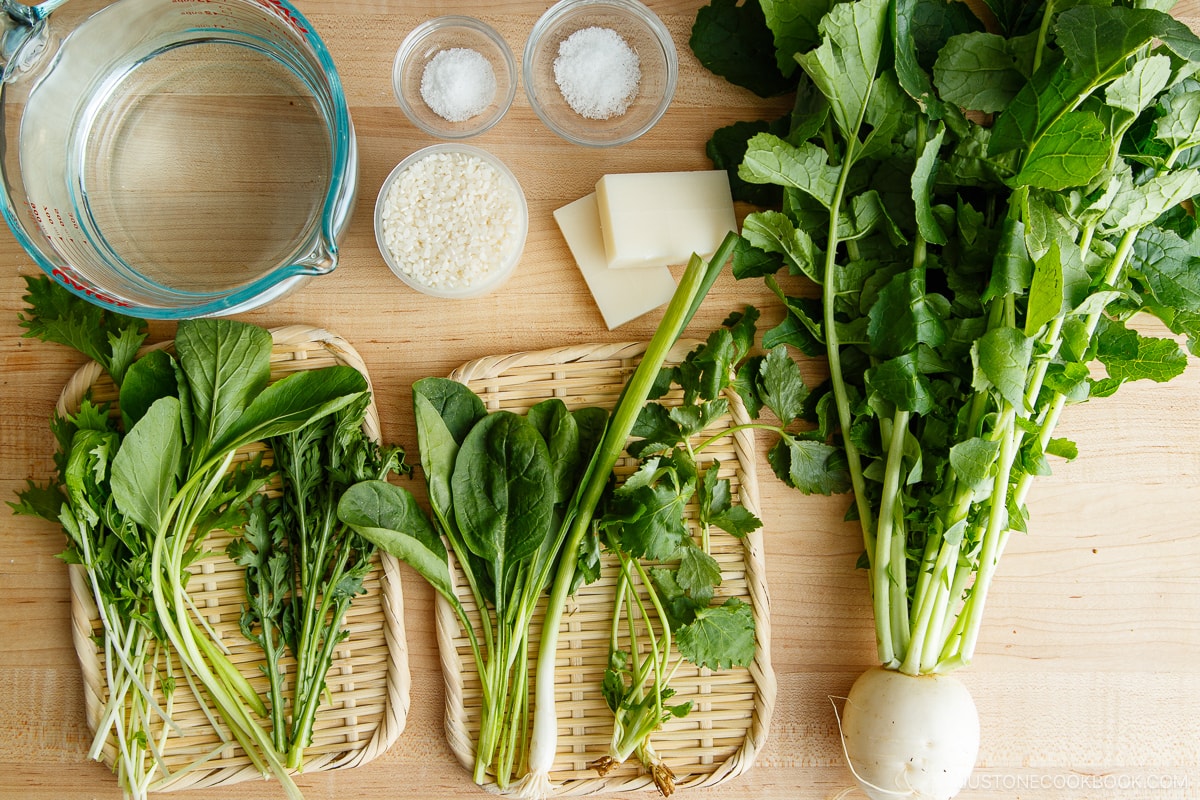
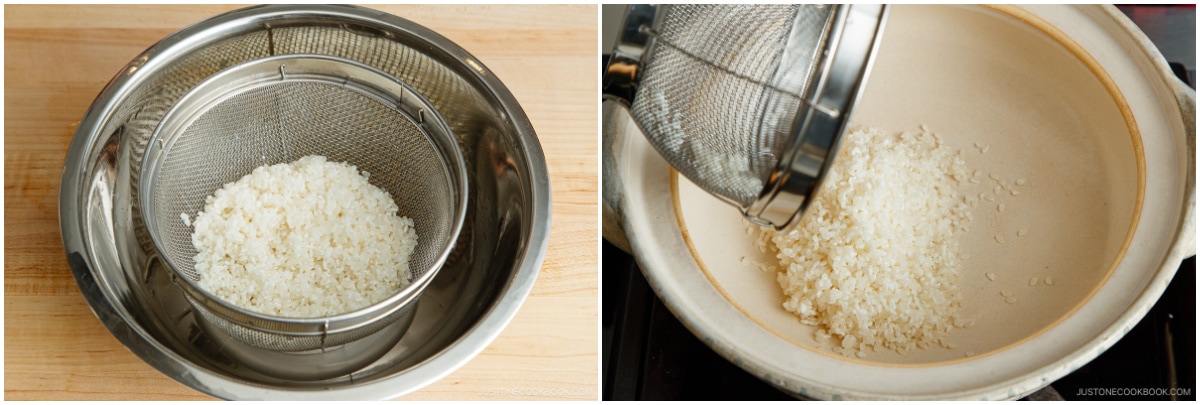
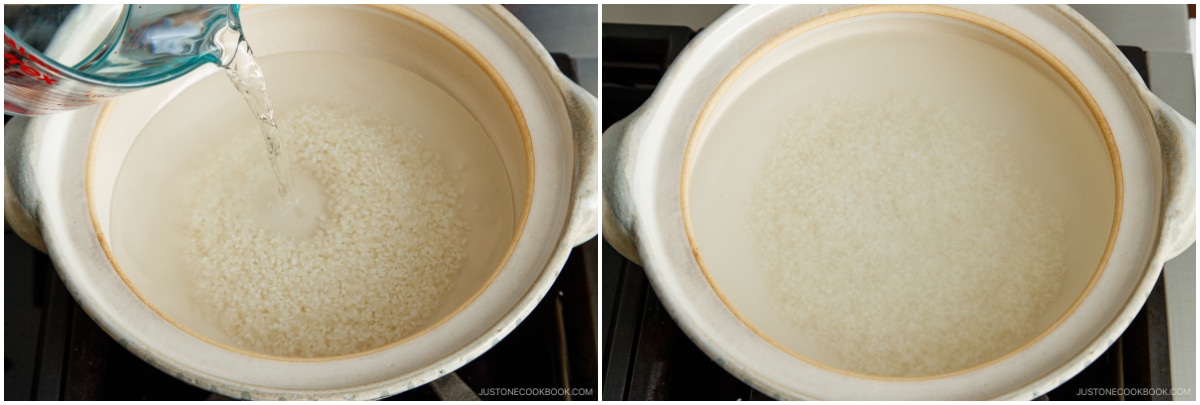
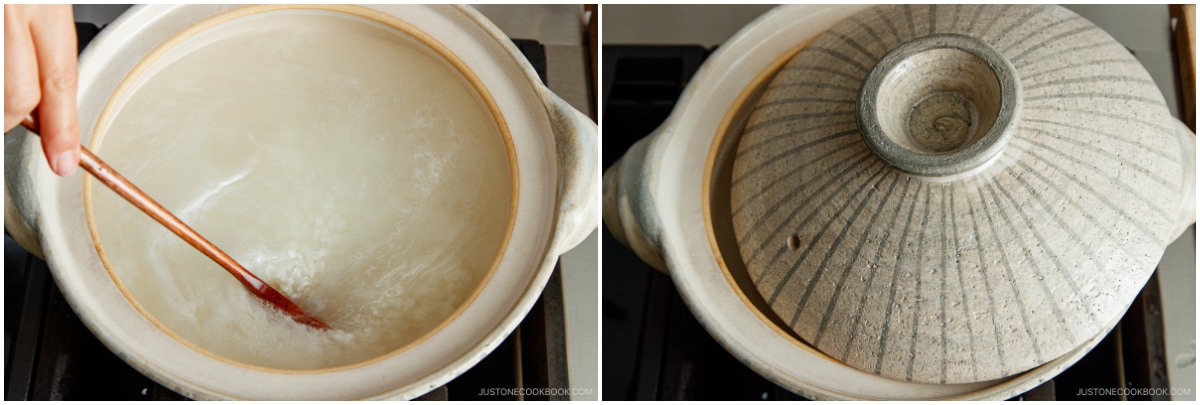
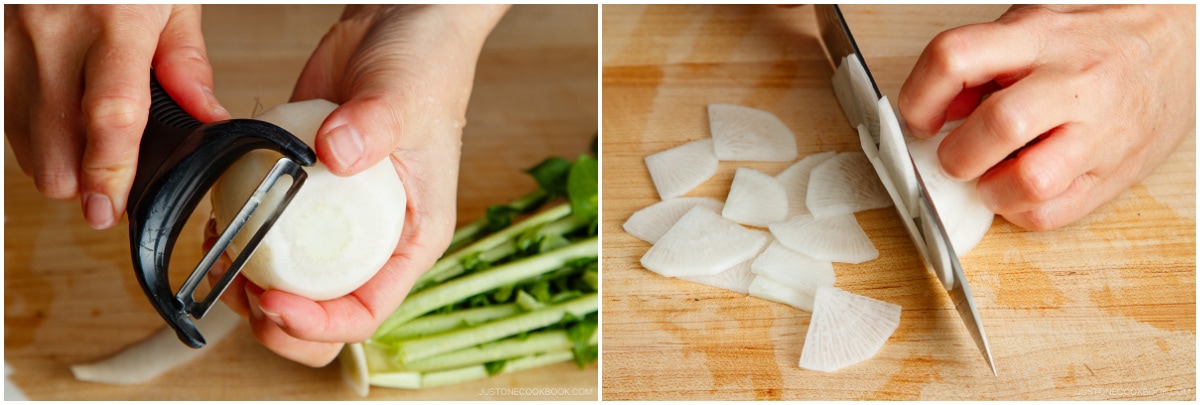
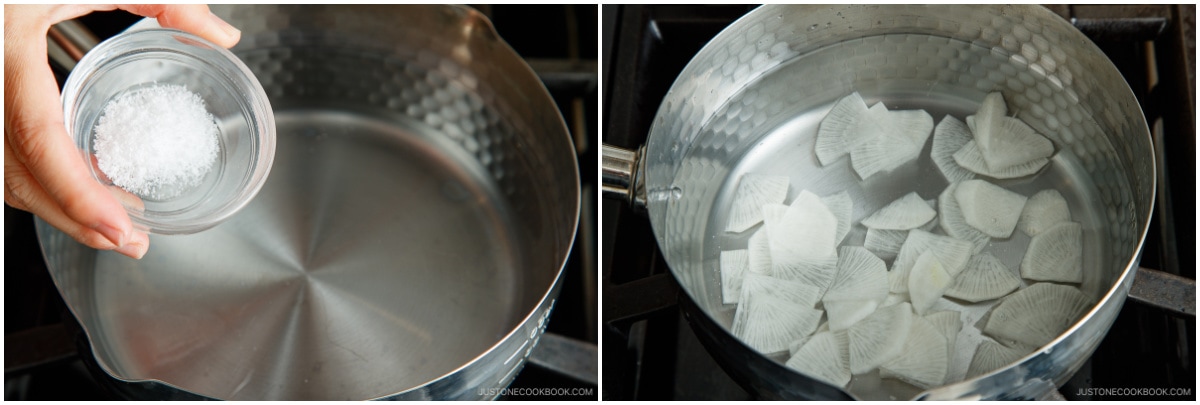
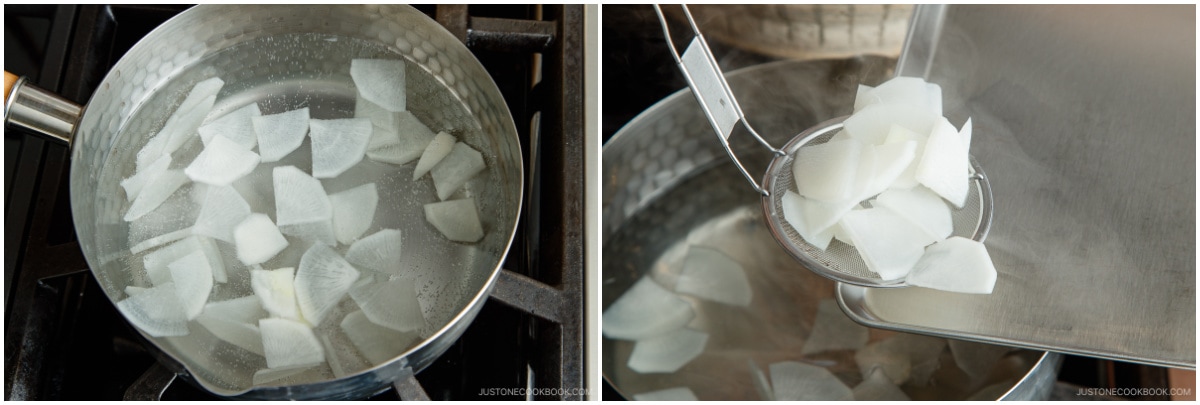
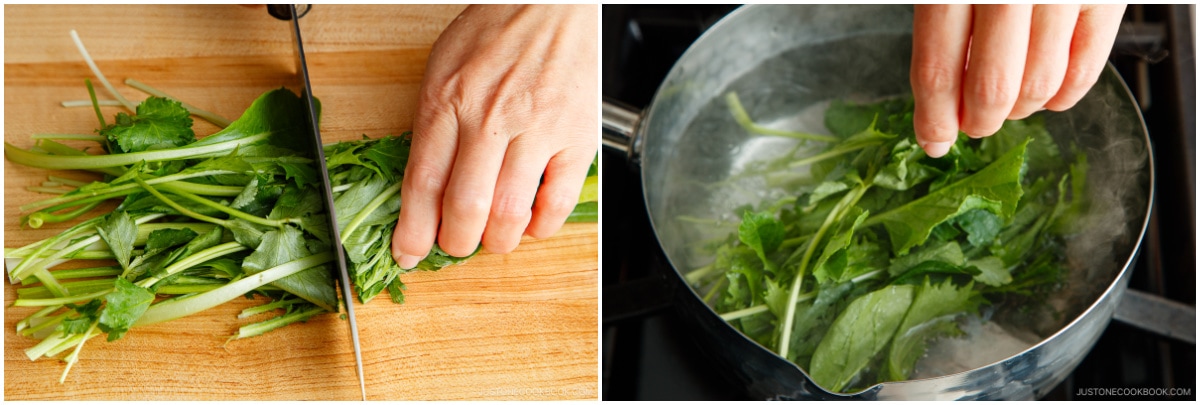
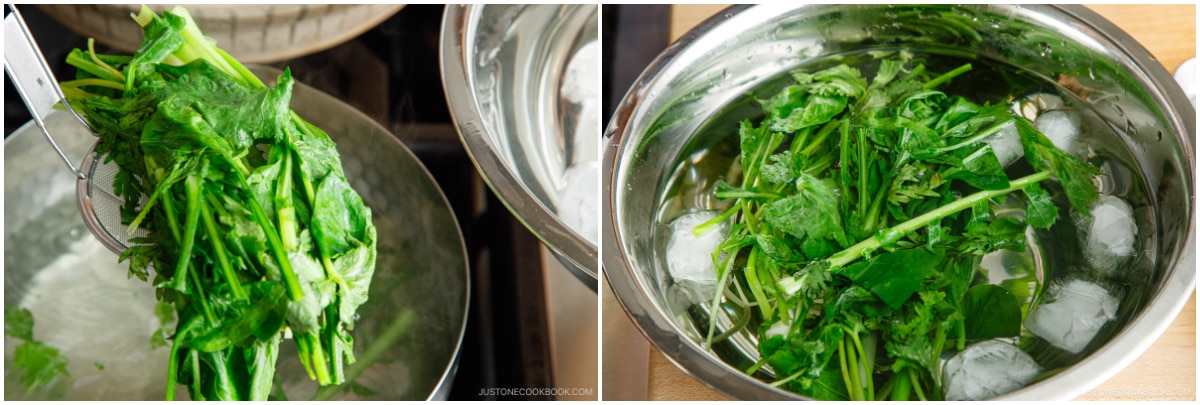
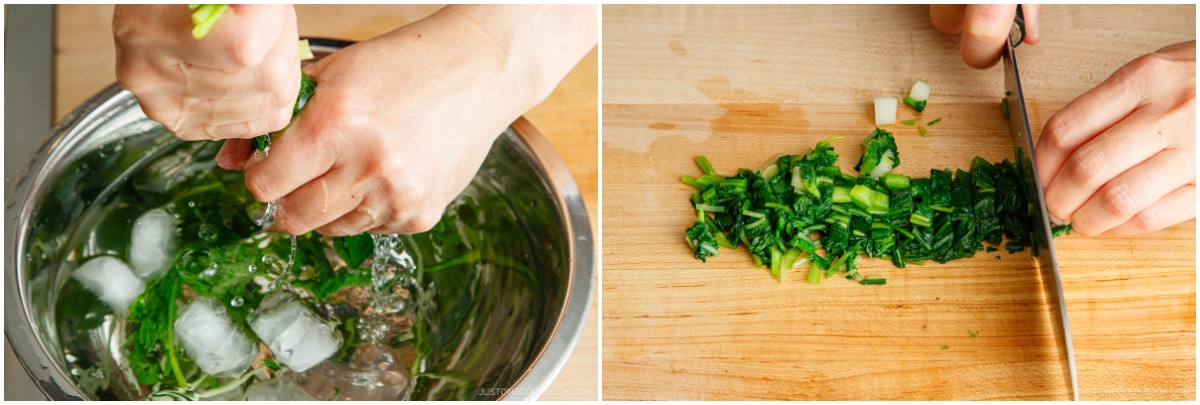
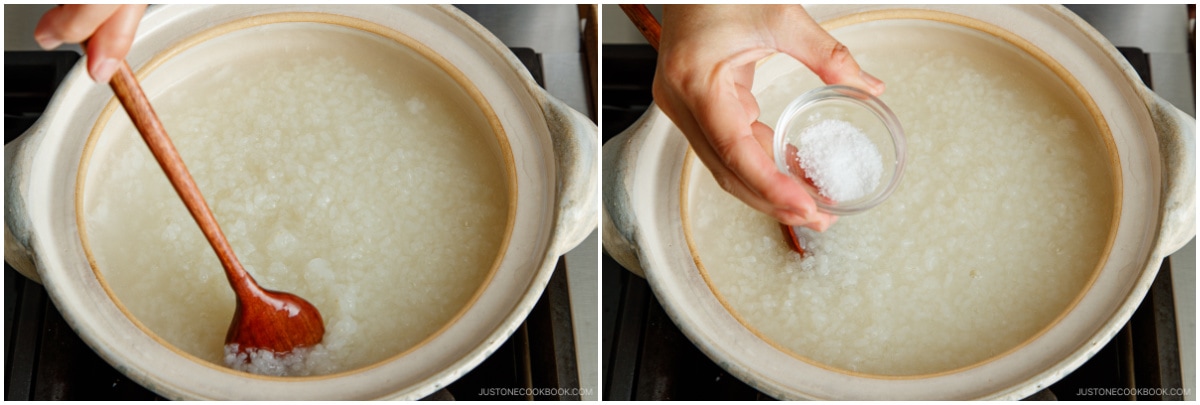
















I followed the recipe but 250 ml is not near enough water – the whole rice burned to the bottom – I made in a rice cooker with 1 cup rice to 5 cups water – it was perfect – so I will try next time w more water in the donabe – disappointed
Hello, Gillian. We’re sorry to hear the outcome wasn’t as great as you expected.
It’s possible that the heat level was somewhat greater than Nami’s setting. We hope you keep this recipe by adjusting the amount of water or lowering the heat even further.
Thank you very much for trying Nami’s recipe and sharing your cooking experience with us.
I have miso soup with rice and herbs almost every morning. Happy New Year!
Hi Bil! Happy New Year! Wow! That is so healthy! 👏🏻
Are the nanakusa gayu herbs available only seasonally (at Nijiya for Jan-7th), or is this something Japanese enjoy year-round?
Hi squidlydeux! These herbs are seasonal, and we usually see the fresh herbs at the Japanese store in early January only. We enjoy simple rice porridge without herbs all year round, but Nanakusa Gayu is a special meal for January 7th.
However, now freeze-dry Nanakusa is available in some stores, people may enjoy it any time of the year.
We hope this helps!
Hi Naomi, thanks for the recipe. I was interested to see one of the herbs was dropwort aka hemlock. Here in the UK it’s quite a common wild plant but known to be extremely poisonous, even fatal! I looked to see if it was a different species in US but it seems to be the same. Btw I love your recipes – very informative, well thought out and easy to follow. I look forward to them. Enjoy your New Year feast!
Hi Jasmin! Thank you very much for reading Nami’s post!
The herbs used in this recipe are Japanese species, and it called “Seri” in Japanese. It’s culinary use and safe to eat.🙂 It might be a challenge to find all the seven herbs outside Japan, but we hope you enjoy this recipe with Nami’s recommended alternative herbs listed in this post. Happy New Year!
Hello Jasmin, I know this is a pretty old comment so you’ve probably already found this out, but the particular type of water dropwort that Nami was referring to is actually a variety that grows mostly in Eastern Asia and is very different from the poisonous water hemlock that most of us know (Oenanthe crocata). The Japanese one is also known as Oenanthe javanica, Chinese celery, or Japanese parsley and is one of the only edible species of plants from this Genus if not the only edible one. Hope this helps maybe you or anyone else who may have concerns about this herb!
Hi Nami-san! Thank you for all of your lovely recipes always 🙂 Do you have a suggestion for a different pot to use if I do not have a donabe? Would a dutch oven work? Also, is it possible to make this in an instant pot? Happy New Year!
Hi Kelly! Thank you very much for reading Nami’s post and trying her recipe!
Yes, you can use a dutch oven for this recipe.🙂
As for instant pot, currently, we do not have a recipe on our site, but it’s possible to use an instant pot. Try cooking the porridge for about 15 minutes? Let us know how it goes!
Thank you for letting us know about freeze dried nanakusa at Nijiya. I found it at the San Francisco store. Made nanakusa gayu in the donabe today, 1/7/2021. Great!
Also want to tell you that a couple of months ago I bought anko at Nijiya and made nabe. Added ankimo as your recipe suggests. It was really tasty. I love ankimo and buy it very often, eat it with ponzu.
Hi Lynne,
It is our pleasure! Thank you very much for trying this recipe and Anko Nabe https://www.justonecookbook.com/monkfish-hot-pot/!
We are so happy to hear you were able to make Nanakusa Gayu on 1/7, and you had a chance to enjoy Anko Nabe last year! Yay!
Nami
Thank you for this recipe. I’ve never heard of it but will go to Nijiya to buy it.
Have you heard of this .. my Uncle use to go herring fishing & my Aunt would make this marinade for the Herring eggs on the fresh Nori. Have you heard of such a thing. My Aunt & Uncle have passed so I can’t ask.
Hi Ginger!
Thank you very much for trying this recipe! We hope you find the ingredients at Nijiya and able to try this Nanakusa Gayu.
As for the Herring eggs on the fresh Nori, It sounds to me like a Herring eggs called Komochi-kombu (子持ち昆布). Please search this Japanese word online and see if that looks similar to what you remember. If it’s the same one as my guess, Yes, Nami has a marinade recipe. https://www.justonecookbook.com/kazunoko/
Her recipe’s Herring eggs are not the ones with Kombu, but the marinade will be the same.
We hope this helps!
Muito boa a receita, pena que não temos todas as ervas disponíveis no Brasil.
Hi Nestor,
We are sorry to hear that you can’t find all the ingredients for this recipe. We hope this recipe becomes more popular in your area, and you can purchase it at your local store or online. Thank you for reading this post!
Obrigado!
The Japanese are so sensible !
Here in Saskatchewan after Xmas & New Year’s indulgences we will celebrate Ukranian Xmas Jan 7 Being Ukranian not required! Healthy resolution starts Jan 8
あけましておめでとう🐂
Hi Vanda,
Wow, one day different to start Healthy resolution!
Thank you very much for your feedback and for sharing the Ukraina Holiday information!
Happy New Year!🎉 明けましておめでとうございます。
Is there a website where the herbs can be purchased?
Hi Shawn,
We had searched online, but unfortunately, we couldn’t find the shop that carries it.😔
Thanks for this recipe. I prefer to refer to New Year’s intentions, rather than resolutions.
Hi Frances! Thank you for your input!🙂
All your recipes looks delicious thanks for sharing Happy New Yearr to you and your staff
Hi June!
Happy New Year!🎍 Thank you very much for your kind feedback!
Hi, I have a question? Since it is hard to find these herbs fresh. Can I use packet and lose teas for the herbs that I can’t find. A few of these herbs as easy to find dried and in tea form at the local apothecary locations I frequent.
Hi Cori,
In Japan, a freeze-dried product is available. But we’ve never tried this recipe with loose teas, so it’s hard to say… maybe try it with a small portion first to see if it works?